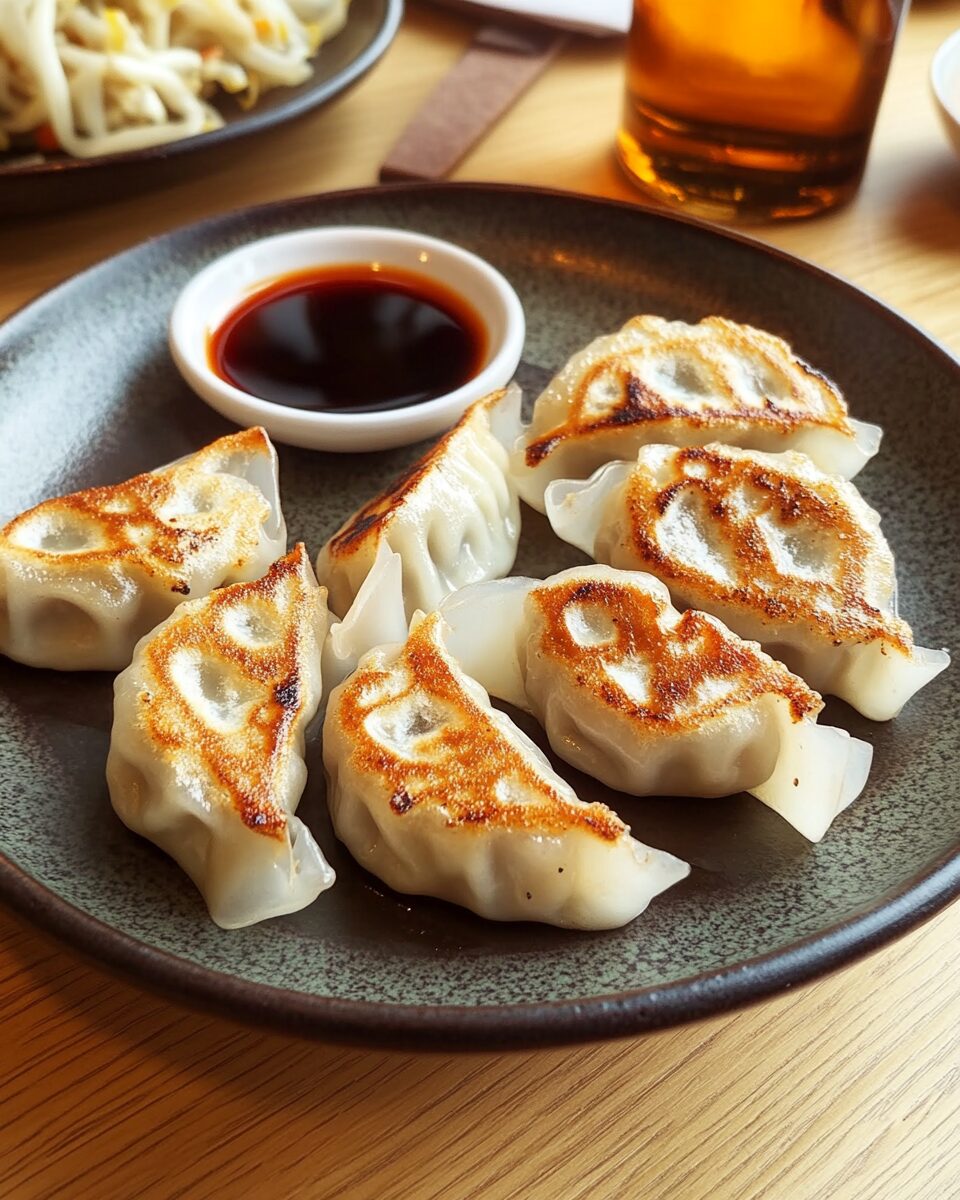The beloved Japanese gyoza—crispy pan-fried dumplings filled with savory meat and veggies—are more than just a restaurant treat. This homemade version is surprisingly simple and makes a fun, interactive kitchen activity that yields incredibly delicious results.
Traditionally filled with ground pork or chicken, cabbage, garlic chives, and shiitake mushrooms, these dumplings are seared to golden perfection then steamed to lock in flavor. Paired with a soy-vinegar dipping sauce, they make an impressive appetizer or a light main dish. Make a big batch, freeze some, and you’ll always be just minutes away from comfort food bliss.
Full recipe:
Ingredients:
For the Gyoza:
-
1 packet (50 count) gyoza wrappers
-
1/8 head of cabbage, finely shredded
-
1 teaspoon salt
-
400 g (14 oz) lean ground pork or chicken
-
1/2 bunch garlic chives, finely chopped (or substitute with green onions)
-
4 dried shiitake mushrooms, soaked in hot water and finely chopped
-
1 tablespoon fresh grated ginger
-
2 teaspoons soy sauce
-
2 teaspoons sesame oil
-
Additional 2 teaspoons sesame oil for cooking
For the Dipping Sauce:
-
2 tablespoons soy sauce
-
2 tablespoons rice vinegar
-
La-Yu (Japanese chili oil), optional
Directions:
-
In a large bowl, combine the shredded cabbage and salt. Let sit for 10 minutes, then squeeze out excess moisture.
-
Mix the cabbage with ground pork or chicken, chopped garlic chives, mushrooms, ginger, soy sauce, sesame oil, and a pinch of salt until well combined.
-
Place a small spoonful of filling into the center of each gyoza wrapper. Moisten the edge with water, fold in half, and pleat to seal.
-
Heat 2 teaspoons of sesame oil in a non-stick pan over medium heat. Place gyoza flat-side down and cook until bottoms are golden brown, about 2–3 minutes.
-
Carefully pour 1/2 cup of water into the pan, cover, and steam for 5 minutes or until water evaporates and filling is cooked through.
-
Mix the dipping sauce ingredients and serve with the hot gyoza.
Prep Time: 25 minutes | Cooking Time: 10 minutes | Total Time: 35 minutes
Kcal: 220 kcal (per 6 dumplings) | Servings: 8 servings (approx. 6 gyoza each)
The Origins of Gyoza: A Cultural Crossroad
Gyoza finds its origin in Chinese cuisine, adapted from jiaozi—traditional Chinese dumplings often enjoyed during Lunar New Year celebrations. Japanese soldiers stationed in China during World War II developed a fondness for jiaozi and brought the concept back to Japan, adapting it to suit Japanese taste and cooking styles. Over time, the dish evolved, leading to the creation of “gyoza” as we know it today.
While the core elements of gyoza remain similar to their Chinese counterpart, several key differences define the Japanese version. Gyoza typically features a thinner wrapper and a more garlicky, finely minced filling, often made with ground pork, cabbage, and aromatics such as ginger and garlic chives. The Japanese preparation also leans toward pan-frying followed by steaming, which results in their signature crispy bottom and soft top—a hallmark of proper gyoza.
A Versatile Dish for Every Occasion
One of the most appealing qualities of gyoza is its versatility. Though often served as a side dish or appetizer, gyoza can easily be the centerpiece of a meal. A generous platter served with a variety of dipping sauces—soy sauce, vinegar, chili oil—makes for a show-stopping main that satisfies cravings for both texture and flavor.
In Japan, gyoza is a common accompaniment to bowls of ramen, forming part of the holy trinity of casual dining along with fried rice. It’s equally at home in a formal dinner setting or as comfort food enjoyed on a rainy evening. Many households prepare large batches and freeze them for quick meals during busy weeks, making gyoza a practical addition to any culinary repertoire.
Texture: The Signature Crispy Bottom
Gyoza’s unique appeal lies in its dual-texture—crispy and golden on the bottom, yet soft and chewy on the top. This comes from the traditional “yaki-gyoza” technique, which involves pan-frying the dumplings until the bottoms are crisp and brown, then adding water and covering the pan to steam the dumplings through.
This method creates the ideal gyoza experience: a satisfying crunch as you bite in, followed by a flavorful, juicy filling. It’s a sensory delight that highlights the delicate craftsmanship behind every dumpling.
The Heart of the Gyoza: Flavorful Fillings
Although pork and cabbage form the classic base, gyoza fillings can vary greatly depending on regional styles or personal preferences. Ground chicken is a lighter alternative that still brings richness, while chopped garlic chives lend a fragrant sharpness that cuts through the savory meat. Rehydrated shiitake mushrooms add earthiness and umami depth, creating complexity in every bite.
The filling mixture is not overly wet—another distinction from Chinese dumplings. The intention is to maintain a cohesive texture that won’t leak during cooking, preserving both structure and flavor. The balance of seasoning is also key, with soy sauce, sesame oil, and ginger used sparingly but purposefully to let the natural flavors of the ingredients shine.
The Joy of Pleating and Assembling
Pleating gyoza is an art form in itself, and while it may take a few tries to master, it’s part of the charm. Typically, the wrapper is folded into a crescent shape, with pleats formed on one side to give the dumpling its iconic curved edge. The method may vary—some pleat both sides, while others prefer a simple fold-and-press style for efficiency.
Dry hands and the right moisture level in the filling are essential to avoid tearing the thin wrappers. As you grow more confident, the uniformity and beauty of your pleats will become a source of pride. Whether you choose to make ten or fifty, the process becomes almost therapeutic—an opportunity to slow down and savor the craft.
Dipping Sauces That Elevate the Experience
Gyoza is typically served with a dipping sauce composed of soy sauce and rice vinegar. This tangy and salty combination highlights the savory richness of the filling. Some prefer to add a touch of La-Yu, a Japanese chili oil that infuses the sauce with smoky heat and depth.
The sauce can also be customized to your liking—add minced garlic, sesame seeds, or even a splash of ponzu for a citrusy twist. The interplay between the dumpling and the sauce enhances each bite, transforming something simple into something extraordinary.
Freezer-Friendly and Meal-Prep Approved
One of the most practical aspects of gyoza is how well they freeze. If you’re taking the time to make gyoza from scratch, it makes sense to prepare a double or triple batch. After folding, simply arrange them in a single layer on a parchment-lined tray and freeze until solid before transferring to a storage bag.
Frozen gyoza can be cooked straight from the freezer using the same fry-and-steam method. There’s no need to thaw them, making it an ideal solution for last-minute meals or unexpected guests. Your future self will be grateful for the foresight.
Healthful and Customizable
Gyoza may not immediately come to mind as a health food, but when made at home, they can be surprisingly nutritious. By controlling the ingredients and portion sizes, you can create a balanced meal rich in protein, fiber, and essential nutrients. Lean meats, lots of vegetables, and minimal oil usage ensure you’re feeding yourself and your loved ones something satisfying and wholesome.
Additionally, gyoza is easily adaptable to dietary needs. Vegetarian versions can include tofu, mushrooms, or finely chopped vegetables, while gluten-free wrappers can accommodate those with sensitivities. It’s a dish that truly caters to everyone.
A Culinary Bridge Between Cultures
Gyoza symbolizes more than just delicious food—it represents a bridge between cultures. With roots in Chinese cuisine and a distinctly Japanese identity, gyoza is a testament to how food evolves and adapts through time and across borders. It’s a dish born of memory, migration, and innovation.
Whether served in a Tokyo street stall or your kitchen at home, gyoza brings people together. It invites connection over the dinner table and provides an opportunity to pass down tradition through taste and technique.
Conclusion: Why Gyoza Belongs in Every Kitchen
If there’s one dish that embodies comfort, culture, and craftsmanship, it’s gyoza. From its crispy texture to its umami-packed filling, every bite tells a story. It’s easy to see why this humble dumpling has earned a spot in the hearts of so many, transcending cultural barriers and generations.
Making gyoza at home may seem daunting at first, but with a bit of practice and patience, it becomes second nature. More than just a recipe, it’s an experience—a way to explore Japanese culinary tradition and enjoy the simple pleasures of cooking from scratch. So whether you’re hosting a dumpling night or preparing a quiet dinner for one, know that gyoza has the power to turn an ordinary meal into something memorable.






